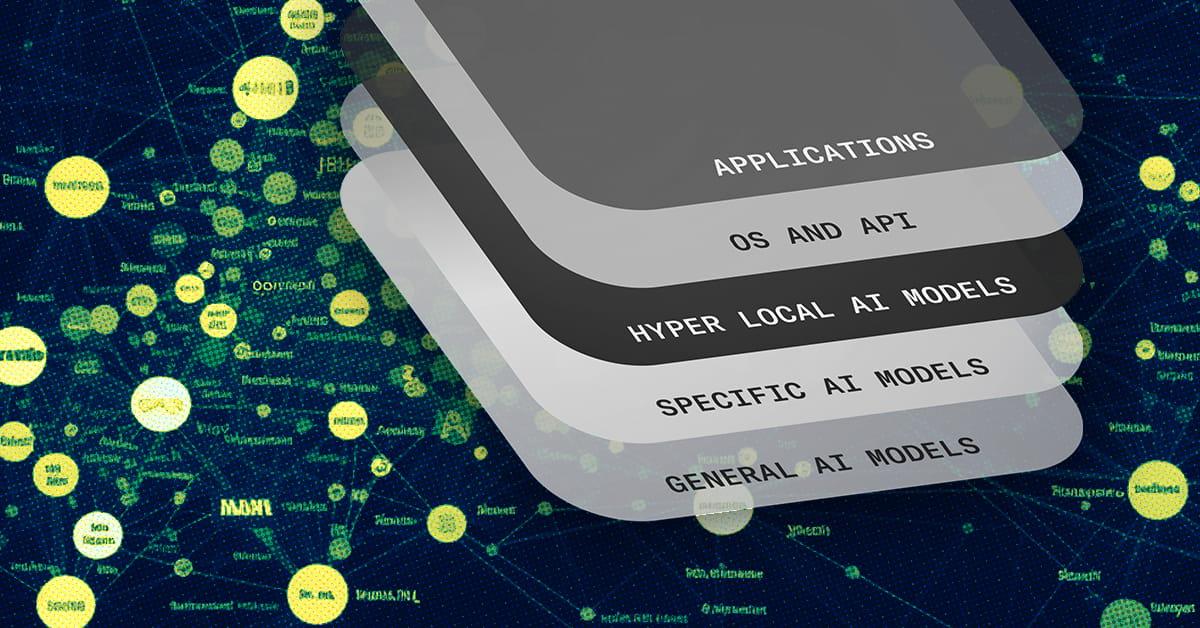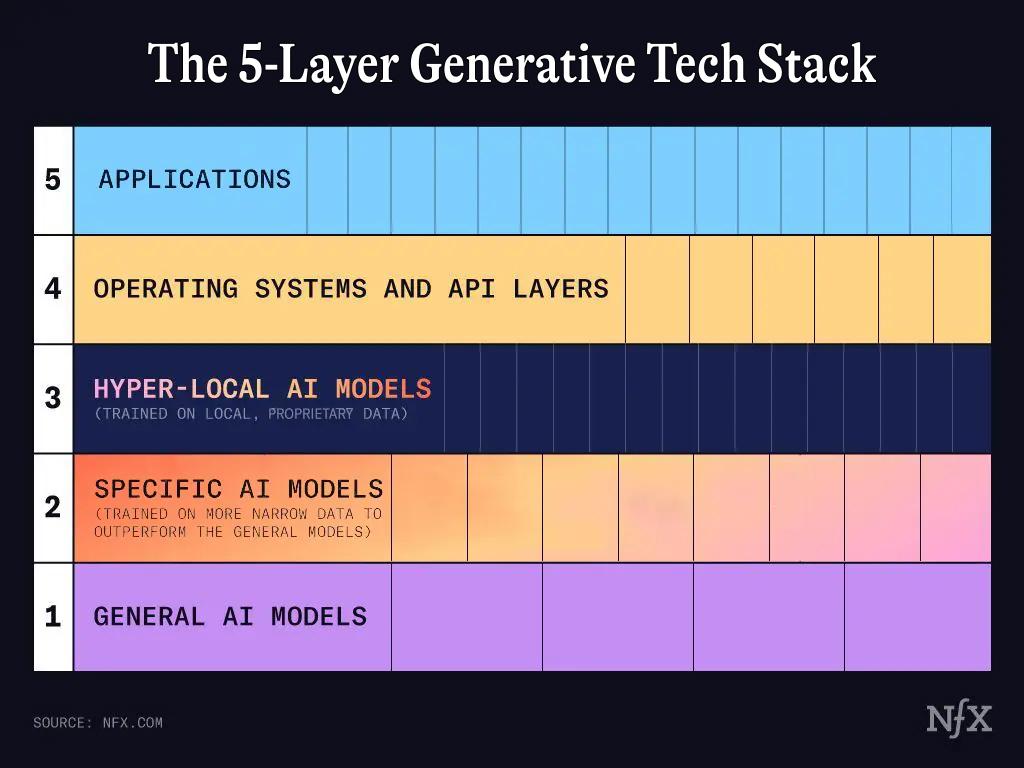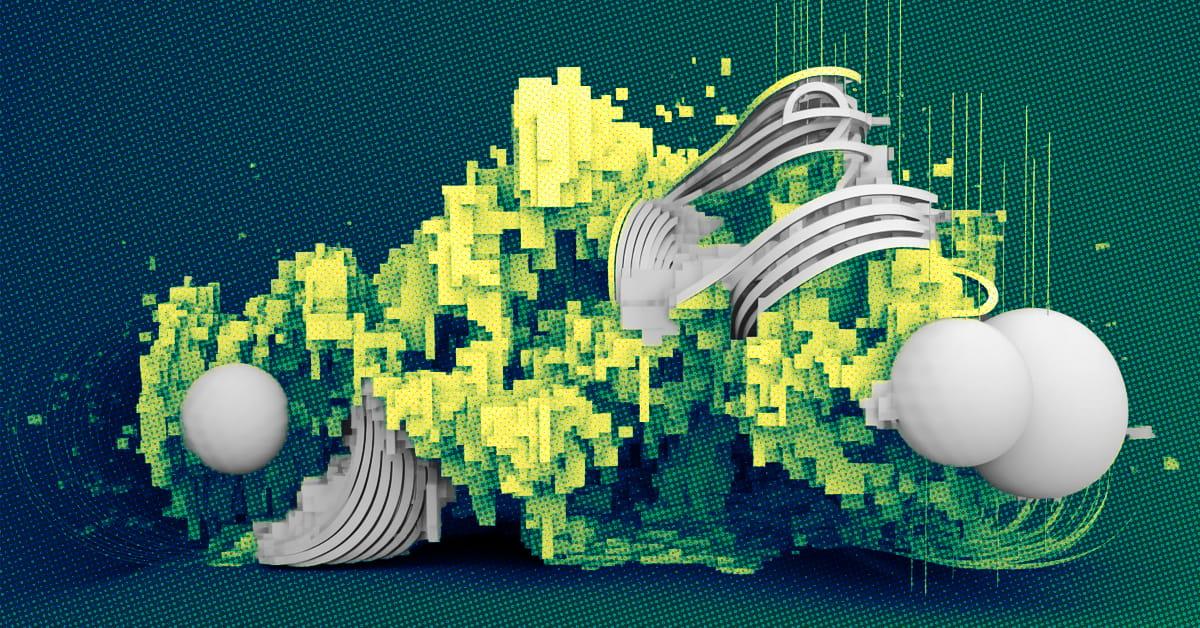

Here is NFX’s Generative AI market map. With now over 550 companies on it already. Add to it. We’re open sourcing it.
If you’re starting a company that touches generative AI, come talk to us.
Below, we discuss what we’re seeing evolve as a 5-layer generative tech stack, to help guide your thinking about your company.
The 5 -Layer Generative AI Tech Stack
We see the generative tech stack breaking down into 5 layers. As a founder, you have to decide which layer or layers you want to include in your product.
5. Applications layer
4. OS or API layer
3. Hyperlocal AI models
2. Specific AI models
1. General AI models
Let’s walk through these.


The AI Model Layers: General, Specific, and Hyperlocal
The AI engines enabling generative tech have three layers. You can use all three depending on what features your market demands, and depending on the level of nuance and specialization required.
- General AI models are the core technology breakthrough. It’s something like GPT-3 for text, DALL-E-2 for images, Whisper for voice, or Stable Diffusion. These models deal with broad categories of outputs: text, images, videos, speech, games. They are going to be open-source, easy to use, and good at all of the above. This is where the generative tech revolution started – but it’s not where it will end.
- Specific AI models capture even more nuance for specific jobs such as writing tweets, ad copy, song lyrics, or generating e-commerce photos, 3D interior design images, etc. These models are trained on more narrow, more specialized data, which should allow them to outperform general models in their specific wheelhouses. Some of these will eventually be open sourced as well.
- Hyperlocal AI models are specialists. A hyperlocal AI model can write a scientific article in the style preferred by Nature. It creates interior design models suited to a specific person’s aesthetic. It can write code in the particular style of an individual company. It can light and shadow a particular company’s e-commerce photos exactly as they want. This model is trained on hyperlocal, typically proprietary data.
These models are obviously children of the data that they’re trained on. As you move up the stack, the data becomes more differentiated, leading to a more nuanced model. It’s easy to assume that this differentiated data is the key to lasting success.
It may or may not be.
Some have said Generative Tech is really a race to gain access to data for the training of AI. But, as we’ve discussed before, data does not always provide a powerful defensibility. Even if a competitor cannot get your exact dataset, they likely can find a similar dataset. Even if their model is not quite as good as yours, customers can’t always tell, and competitors can claim to have what you have in their sales materials. That means most data network effects asymptote over time. An AI model that is 5% or even 20% percent better than the competition is a pretty slim defensibility.
There’s a further challenge: human ability to appreciate what’s generated, has a limit. And the AI is getting to that limit fast.
For instance, humans can’t tell much difference between 4K photos and 8K because our eyes can’t take more pixels. People’s brains won’t be able to tell the difference between human writing and AI writing within 24 months. Most people will enjoy music and lyrics written by AI in 36 months. (And yes, this makes a lot of people very uncomfortable).
The AI models are moving very fast, so it’s not going to take long, maybe 3 years for many general and specific models to approximate each other and reach those human limits. The ability for these models to differentiate themselves stops at those limits, assuming pennies per generation and speeds of a few seconds.
[Note: as of today, there is no generative AI “past the limit of humans” until other AI’s start having money to pay for content generated past the human limits.]
So the best place to explore data network effects in your AI models is probably at level 3, the hyperlocal layer, which benefits from proprietary and trusted data.
The Operating Systems and API Layer
This is the layer that sits between the workflow applications and the AI models below. I might have an application for making an ecommerce website. Several different people need to use that application. They each need different models for doing their role. This API layer or Generative OS helps that application access all the AI models the application needs. This layer also allows for the AI models to be switched out at will. Which of course tends to commodify them.
This layer eases interoperability of the applications and workflows. It helps keep track of identity, payments, legal issues, terms of service, storage, etc. It helps the application developers try more features faster and get them up and running faster. For the end user, it removes hassle from the AI models below and the application vendors above. This layer should have powerful network effects and embedding characteristics.
The Applications Layer
These applications are interfaces where humans and machines collaborate. These are the workflow tools that make the AI models accessible in a way that enables business customers or consumer entertainment.
In this layer it’s easy to envision network effects or embedding defensibilities.
There will be 10,000’s of these applications built for various needs in the next 2 years. Incumbent software providers will add generative features. New companies will create competitors to the old, emphasizing generative as a wedge. New companies will create brand new applications people will use with generative AI as a starting point.
How to Win in Generative Tech Right Now
Given that everyone is having similar ideas right now (see NFX’s Generative Tech Market Map – collectively, these companies have raised $14B+ already) – then how do you compete?
1. Product Speed
You need to get product in market, see what works, what doesn’t. See what makes people uncomfortable – and get them through that cycle. Watch your competitors closely and borrow the best ideas. Don’t make it perfect. Don’t spend too much time hunting down specific data in hopes of building the perfect model if it comes at the expense of other layers in the stack (your application, API or OS layer). Launch the feature first, let the model learn over time.
One good example of this is Jasper’s recent “Tweet generator” which according to users is “an absolutely god-awful beta.” Jasper clearly needs a specific AI model for this feature. I suspect they’re building one or planning to borrow one, but they did the right thing by launching the beta anyway and getting on the field with it. You should follow their example with whatever you’re working on.
2. Sales Speed
As Generative AI moves from feature to product to real businesses, you might consider that aggressive sales and marketing, not just AI and ML, will rule 2023 – 2024. Aggressive sales will help embed your product in your customers and give you the right to expand into other categories. Aggressive sales will help you build network effects to help your defensibility. Sales will help you with advantages #2 and #1 above.
3. Network Effects
Network effects will help you win, particularly at the application and OS/API levels. We’ve written a Manual and produced a 3-hour Masterclass season to help you think about these.
4. Embedding
If the AI models, layers 1-3, trend to commodities, then it might make sense to look at how the applications and APIs you build on them help you keep your customers by embedding them in their workflows or their daily lives.
5. Find an investor who will sprint with you
Take this technology and sprint with it. You need an investor who will sprint with you. Come talk to us.
As Founders ourselves, we respect your time. That’s why we built BriefLink, a new software tool that minimizes the upfront time of getting the VC meeting. Simply tell us about your company in 9 easy questions, and you’ll hear from us if it’s a fit.


